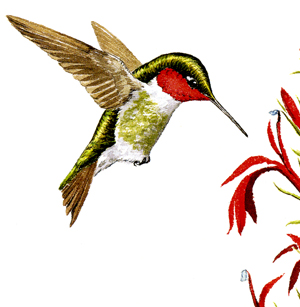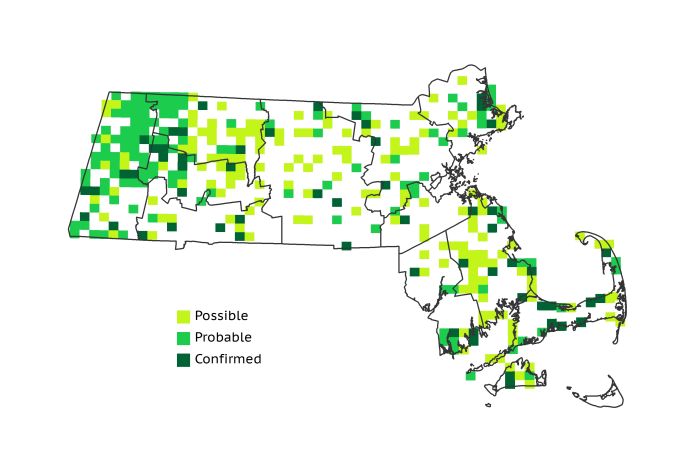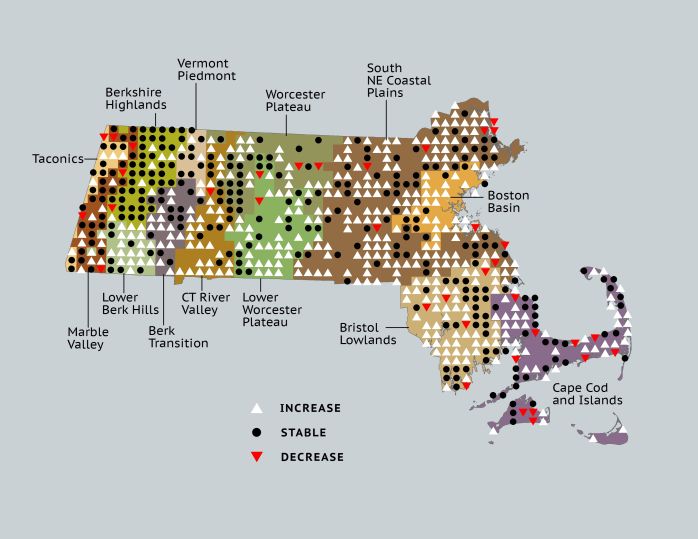Find a Bird
Ruby-throated Hummingbird
Archilochus colubris

Nearly ubiquitous and strongly increasing

“A flash of harmless lightning, / A mist of rainbow dyes, / The burnished sunbeams brightening, / From flower to flower he flies...”— John Banister Tabb, “The Humming-Bird”
Our smallest breeding bird is also one of our most beautiful. The male Ruby-throated Hummingbird is unmistakable, with glossy green feathers above and a stunning gorget that glitters like its namesake gem. Even the female Ruby-throated Hummingbird is easily identified because this species is the only hummingbird that reliably nests in New England. Ruby-throated Hummingbirds are favorites of backyard birders, and hummingbird feeders are a popular addition to many backyard gardens. Hummingbirds have taken readily to suburban living, and they have prospered accordingly as towns have grown.
Historic Status
Among the earliest bird species chronicled in the United States it was the diminutive, rapid-flying Ruby-throated Hummingbird that captured the attention of Old World travelers like no other species. In the early seventeenth century, William Wood noted, “For colour she is as glorious as the Raine-bow; as she flies, she makes a little humming noise like a Humble-bee; wherefore shee is called the Humbird” (Wood 1634). After two centuries passed, the “beautiful little visitor” still arrived each spring in “considerable numbers” and thrived in the bountiful orchards then in vogue (Peabody 1839). Eighty years later, with farmlands and orchards gradually vanishing and forests returning, the population likely began to diminish, although Forbush continued to list the bird as common (Forbush 1927). By the 1970s, the effects of widespread habitat change across Massachusetts became more apparent.
Atlas 1 Distribution
Ruby-throated Hummingbirds bred irregularly throughout the Commonwealth during Atlas 1. The highest concentrations of breeding activity were found in the west. The Berkshire Highlands had the highest block occupancy of any ecoregion (76%), with the Marble Valleys (72%) not far behind. A notable dip in hummingbird concentration was evident through the Lower Berkshire Hills and Connecticut River Valley, and hummingbird block occupancy was only slightly higher in the Worcester Plateau region. Hummers were also widely but patchily distributed through the Coastal Plains. The Bristol/Narragansett Lowlands showed a noticeable aggregation of blocks with hummingbird activity along the region’s eastern edge, but the neighboring Cape and Islands had only 33% block occupancy.
Atlas 2 Distribution and Change
The proliferation of natural beaver clearings and cultivated suburban gardens during Atlas 2 provided ideal conditions for Ruby-throated Hummingbirds. Hummingbirds increased their footprint throughout the state in the years leading up to Atlas 2, remaining widespread in the westernmost areas while capturing a great deal of new territory in the central and eastern regions of the Commonwealth. Every region from the Connecticut River Valley eastward to the Bristol/Narragansett Lowlands reported breeding Ruby-throated Hummingbirds in at least 59% of all blocks, and in many cases that number was quite a bit higher. The growth on Cape Cod and the Islands was more modest, but hummingbirds were unquestionably an expanding species during the time of Atlas 2.
Atlas 1 Map

Atlas 2 Map

Atlas Change Map

Ecoregion Data
Atlas 1 | Atlas 2 | Change | ||||||
Ecoregion | # Blocks | % Blocks | % of Range | # Blocks | % Blocks | % of Range | Change in # Blocks | Change in % Blocks |
Taconic Mountains | 10 | 62.5 | 2.9 | 20 | 80.0 | 2.5 | 4 | 26.7 |
Marble Valleys/Housatonic Valley | 28 | 71.8 | 8.2 | 33 | 84.6 | 4.1 | 5 | 12.8 |
Berkshire Highlands | 42 | 76.4 | 12.2 | 51 | 92.7 | 6.3 | 8 | 15.1 |
Lower Berkshire Hills | 9 | 32.1 | 2.6 | 29 | 93.5 | 3.6 | 18 | 66.7 |
Vermont Piedmont | 9 | 52.9 | 2.6 | 17 | 100.0 | 2.1 | 4 | 33.3 |
Berkshire Transition | 18 | 47.4 | 5.2 | 37 | 92.5 | 4.6 | 16 | 51.6 |
Connecticut River Valley | 14 | 25.0 | 4.1 | 51 | 78.5 | 6.3 | 27 | 56.3 |
Worcester Plateau | 29 | 37.2 | 8.5 | 78 | 88.6 | 9.6 | 20 | 41.7 |
Lower Worcester Plateau | 20 | 27.0 | 5.8 | 64 | 80.0 | 7.9 | 28 | 51.9 |
S. New England Coastal Plains and Hills | 73 | 27.0 | 21.3 | 222 | 78.4 | 27.4 | 114 | 50.4 |
Boston Basin | 8 | 14.3 | 2.3 | 34 | 60.7 | 4.2 | 26 | 47.3 |
Bristol and Narragansett Lowlands | 38 | 35.8 | 11.1 | 89 | 78.1 | 11.0 | 48 | 47.5 |
Cape Cod and Islands | 45 | 33.1 | 13.1 | 85 | 59.0 | 10.5 | 33 | 27.5 |
Statewide Total | 343 | 35.4 | 100.0 | 810 | 78.1 | 100.0 | 351 | 42.3 |
Notes
In accordance with Atlas increases, the Ruby-throated Hummingbird shows significant increasing Breeding Bird Survey trends in Massachusetts, in the New England/Mid-Atlantic Region, and in the Eastern US overall.



